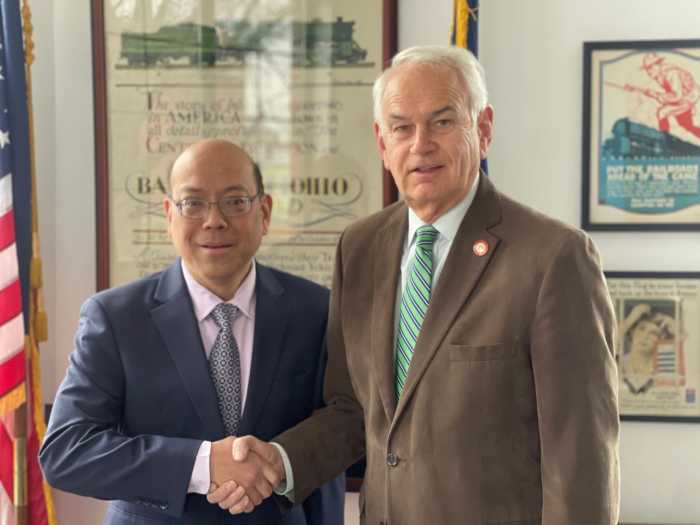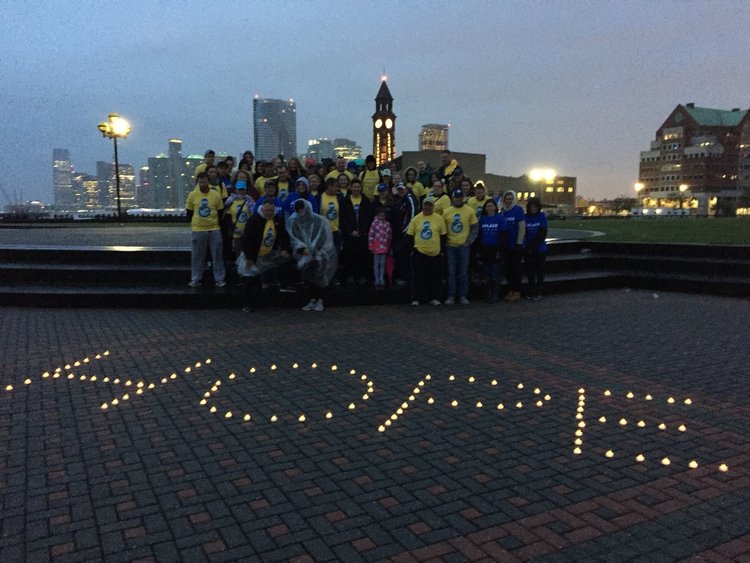By Daniel Massey
Against the backdrop of two towering beech trees Jacob Riis planted a year after his wife’s death, Richmond Hill historians rededicated the grave of Elisabeth Riis Saturday in a ceremony at Maple Grove Cemetery in Kew Gardens.
Jacob Riis, a journalist and urban reformer best known for his groundbreaking book on tenement life, “How the Other Half Lives,” lived with his family in Richmond Hill at 84-29 120th St. beginning in the late 1800s. Elisabeth died in that home of pneumonia in 1905 at the age of 52 and was buried in a modest grave just off Kew Gardens Road.
Riis affectionately called his wife his “little lamb” and placed a carving of a reclining lamb on top of the gravestone. He planted the two now-massive beech trees, a small laburnum and a red azalea bush and for a year after her death brought flowers to the grave each day.
“We went looking for Elisabeth’s grave, but it was buried in leaves. There was no head on the lamb,” said Richmond Hill Historical Society President Nancy Cataldi. “The love story is so strong and so beautiful that I felt bad it was so neglected and left alone.”
During the 20-minute ceremony, Cataldi and local historian Carl Bellenas read excerpts from Riis’ diaries that showed his undying love for his wife. They also unveiled the refurbished sections of Elisabeth’s gravestone, including a new laburnum, a freshly planted red azalea bush and a “new” antique lamb, lying down on top of the headstone.
Jacob and Elisabeth met in Denmark when Jacob was 20 and Elisabeth was 17, but because Jacob was a carpenter, Elisabeth’s family would not allow her to marry below her class. Devastated, Riis traveled to America in 1870, where he hoped to earn enough to one day marry Elisabeth.
While Riis was in America, Elisabeth married a soldier. But he kept her in his heart and when the soldier died, Riis again proposed marriage to Elisabeth.
Cataldi read Riis’ recollection of the proposal to City Councilman Dennis Gallagher (R-Middle Village) and about 15 others who gathered for the rededication at the graveside, which last was visited in 1968, according to cemetery records.
“There sat her father in the chair. And he said to Elisabeth, ‘Now you must make your choice — he or us — and then my lamb did not say a word, went over to me and put her hand in mine, for that moment and for the whole life,’ ” Cataldi read.
The Riises moved to Richmond Hill after Jacob stumbled across the neighborhood while on a long walk.
“I came upon Richmond Hill and thought it was the most beautiful spot I had ever seen,” he wrote in 1901. “I went home and told my wife that I had found the place where we were going to live…The very lights of the city were shut out. So was the slum, and I could sleep.”
Riis did much of his work, including the writing of “How the Other Half Lives,” from a small shed behind his home on 120th Street, which was then called Beech Street. From that hideout, he exposed the evils of overcrowded, unsanitary housing, a polluted water supply and lack of adequate recreational and educational facilities for children.
He is credited with starting the ceremonial tradition of lighting municipal Christmas trees and popularizing Christmas caroling. Cataldi said the historical society plans to revive the Christmas carol tradition this winter and also hopes to name a Richmond Hill school in Riis’ memory.
Jacob and Elisabeth Riis had eight children together, three of whom were buried beside their mother. A fourth child from Riis’s second marriage to his secretary was also buried with Elisabeth. Riis died in 1914 and was buried on a farm in Massachusetts.
Reach reporter Daniel Massey by e-mail at Timesledger@aol.com or call 229-0300, Ext. 156.
































